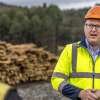
Managing trees: Supporting farmers to make choices
Posted 01 February 2024
Plantation planning Managing trees Tree Alliance
Managing trees is not a one-size-fits-all exercise. It’s about understanding why you are planting trees and knowing how to manage your plantation to reach those goals. Managing trees covers activities from pest control, to pruning trees, to organising a planned burn. But it also involves the flexibility to respond to the needs of your trees over time – and enjoy the journey while you’re doing it.
Rowan Reid is an agroforestry expert who has helped hundreds of farmers to successfully grow trees on their land. We asked Rowan about his approach to managing farm plantations.
Consider your goals
There are multiple ways of managing trees and plantations. Activities vary depending on the condition, location and purpose of a plantation. Rowan Reid, Forester and Lecturer at The University of Melbourne, says it’s important for farmers to understand their needs and goals as part of their management approach.
"The first thing I do with landholders is actually explore why they might want to grow trees," says Rowan.
"It falls into four categories. The first is to grow trees if and where they support current enterprises, so that might be for shade and shelter or soil conservation.
"The second is land care, so biodiversity and conservation. The third is producing products, for example, commercial wood or even fence posts to use on the farm.
"The last is aesthetics and legacy. That’s what it feels like to walk through your farm and think about the legacy you’re going to leave behind.
"So it’s about finding whatever is appropriate to those landholders," says Rowan. "When you have that conversation, landholders say, “okay, it’s my choice, I can choose what I want to do with forestry."
Gain the knowledge
Understanding your goals for tree growing is the first step. Then, it’s about knowing how to achieve them. Education can help farmers to make informed decisions about managing a plantation.
"Landholders need to be able to articulate how the forest can meet the outcomes they’re after," says Rowan.
"To solve a land degradation problem, for example, they’ve got to understand how erosion is occurring and how trees can fix it. It’s the same with shelter, with economic diversification, or whatever their motivations might be.
"It’s building that connection between what you plant and the motivation you have.
"We take landholders to the sawmill so they can understand the difference between a good log and a bad log, so they can go back to their forest start thinking, “okay, how do I prune the trees to improve the wood quality?”
"It’s giving landholders enough knowledge to ask the right questions. Then, they can ask foresters, they can talk to the community, whatever they’re comfortable with.’
Adapt and grow
With knowledge comes the ability to work with trees and produce the outcomes you want. During this process, you can build skills to experiment with your plantation management and see what fits in the long term.
"We encourage people to start small and build up knowledge, so that you’re aware of what’s coming up in the future," says Rowan.
"You respond to your forest and guide it where you want to take it. Pruning, thinning, weed control, mixed spacing, all these management decisions are about asking, “how am I going to direct the forest?”
"It’s not implementing a recipe over 15 or 20 years, it’s seeing how things go, adapting the management, asking questions," says Rowan, "it’s a continuous journey.
"If you're enjoying it and you're getting benefits, you'll keep taking it in the right direction."
See the benefits
By going on the journey of forestry, you can unlock the benefits of trees. Forest management will vary between sites, farming operations and individual farmers, which is why trees can make an ideal solution in many scenarios.
"If landholders are achieving a range of benefits from their trees – whether that’s erosion control or shelter or biodiversity – we find that they're prepared to hold on to their trees for much longer than someone who was growing them to get the money in the bank as soon as possible," says Rowan.
"The good thing about that is, if the forest has been well managed, the trees are actually going to be larger and better quality in most cases. Then they’re more likely to be able to compete in a market.
"Forestry can help lots of different people at lots of different scales," adds Rowan.
"It has something to offer farmers and communities who are looking to improve their environment, solve problems, diversify their income, whatever they want to do. Tree growing and managing forests can be part of that.
"Trees are the answer. Now the question to farmers is, “what is your question?”’
Learn more about the ‘hows’ and ‘whys’ of managing trees with the Tree Alliance Knowledge Hub at treealliance.com.au









